Click on images to enlarge
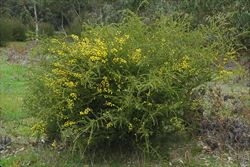
habit (Photo: Rob and Fiona Richardson)

habit (Photo: Rob and Fiona Richardson)
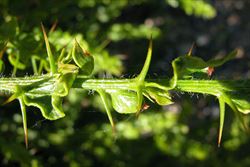
close-up of hairy younger stem and paired spines (Photo: Greg Jordan)
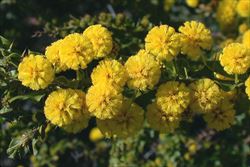
small globular flower clusters (Photo: Rob and Fiona Richardson)
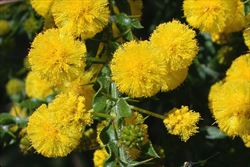
close-up of globular flower clusters with prominent stamens (Photo: Rob and Fiona Richardson)
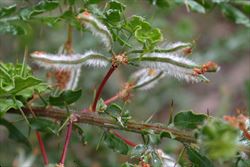
immature fruit (Photo: Rob and Fiona Richardson)
Scientific Name
Acacia paradoxa DC.
Synonyms
Acacia armata R. Br.
Acacia armata R. Br. forma armata
Acacia armata R. Br. forma hybrida (Benth.) Voss
Acacia armata R. Br. forma micrantha (A. Dietr.) Voss
Acacia armata R. Br. forma microcantha (A. Dietr.) Voss
Acacia armata R. Br. forma ornithophora (Sweet) Voss
Acacia armata R. Br. forma tristis (Graham) Voss
Acacia armata R. Br. forma undulata Voss
Acacia armata R. Br. var. angustifolia Benth.
Acacia armata R. Br. var. angustifolia Benth. ex A.D. Chapm.
Acacia armata R. Br. var. armata
Acacia armata R. Br. var. bartheriana hort. ex Chopinet
Acacia armata R. Br. var. linearifolia Ser.
Acacia armata R. Br. var. longipedunculata Regel
Acacia armata R. Br. var. microphylla Benth.
Acacia armata R. Br. var. ornithophora (Sweet) Benth.
Acacia armata R. Br. var. paradoxa (DC.) Ser.
Acacia armata R. Br. var. pendula Seem.
Acacia armata R. Br. var. plana Ser.
Acacia armata R. Br. var. typica Domin
Acacia armata R. Br. var. undulata Riebe
Acacia armata R. Br. var. undulata Domin
Acacia armatoides Walp.
Acacia barteriana hort. ex Jacques
Acacia bartheriana hort. ex Jacques
Acacia furcifera Lindl.
Acacia hybrida Lodd. ex Benth.
Acacia hybrida Lodd.
Acacia microcantha A. Dietr.
Acacia ornithophora Sweet
Acacia tristis Graham
Acacia undulata Spin
Acacia undulata Spin var. undulata
Acacia undulata Willd.
Acacia undulata Willd. ex H.L. Wendl.
Acacia undulata Willd. ex H.L. Wendl. var. elegans hort. ex Jacques
Acacia undulata Willd. ex H.L. Wendl. var. longispina hort. ex
Acacia undulata Willd. ex Spreng.
Mimosa armata (R. Br.) Poir.
Mimosa paradoxa Dum.Cours.
Mimosa paradoxa (DC.) Poir.
Phyllodoce armata (R. Br.) Link
Phyllodoce undulata (Spreng.) Link
Racosperma armata (R. Br.) Mart.
Racosperma paradoxum (DC.) Pedley
Racosperma undulata (Willd. ex H.L. Wendl.) Mart.
Family
Fabaceae: sub-family Mimosoideae (New South Wales)Leguminosae (South Australia)Mimosaceae (Queensland, the ACT, Victoria, Tasmania, Western Australia and the Northern Territory)
Common Names
acacia hedge, hedge acacia, hedge wattle, kangaroo acacia, kangaroo thorn, kangaroo thorn wattle, kangaroo wattle, kangaroothorn, paradox acacia, prickly acacia, prickly hedge wattle, prickly hedge-wattle, prickly Moses, prickly wattle
Origin
Native to large parts of southern and eastern Australia (i.e. from the Eyre Peninsula in South Australia through to south-eastern Queensland). It is most prominent in Victoria, eastern New South Wales and south-eastern South Australia. Also relatively common or scattered in the ACT and south-eastern Queensland and present in other parts of New South Wales. Some botanists also consider it to be native to south-western Western Australia.
Note: the exact native range of this species is somewhat obscure, because it has been widely planted since early settlement.
Naturalised Distribution
Naturalised in Tasmania and in south-western Western Australia. Possibly also naturalised beyond its native range in parts of south-eastern Australia (e.g. in parts of the ACT and Victoria).
Notes
Kangaroo thorn (Acacia paradoxa ) is regarded as an environmental weed in Tasmania and Western Australia. It is sometimes regarded as being weedy within its native range, particularly when growing in native pastures, but has also become naturalised outside its native range or in habitats beyond its normal ecological range. For this reason it is sometimes also regarded as an environmental weed in the ACT and Victoria.
This species grows naturally in open woodlands in the temperate areas of Australia, however it is also planted or becomes naturalised in other habitats. Kangaroo thorn (Acacia paradoxa) was widely cultivated as a hedging plant in the past, particularly in the temperate regions of south-eastern Australia, and is also commonly known as "hedge wattle". Kangaroo thorn (Acacia paradoxa) has definitely become naturalised in parts of Tasmania, and is regarded as an invasive mainland wattle in this state. However, its status is other parts of Australia is not as clearly defined. This species grows in swampy areas, on flats, and along drainage areas in the south-western parts of Western Australia. It has sometimes been listed as native to this region, but it is now largely thought to have been introduced to this region and the Western Australian Department of Environment and Conservation currently list its status as "alien".
While kangaroo thorn (Acacia paradoxa) is native to large parts of Victoria, it is sometimes regarded as being an environmental weed or problem species in this state, and it used to be declared noxious because it provided a refuge for pest animals such as rabbits. There is also some evidence that it has spread beyond its native range in some parts of the state, particularly into coastal areas. It is listed as a native plant that is an environmental weed on the Mornington Peninsula in Victoria and there is also concern about the amount of kangaroo thorn (Acacia paradoxa) growing in Bay Road Heathland Sanctuary in the bayside suburbs of Melbourne. Some consider it part of the original vegetation, but others regard it as being introduced to this area.
Historical plantings may have also caused this species to spread to other habitats within its geographical range, but outside its normal ecological range, in south-eastern Australia. The impact of changes in land managment since European settlemant may also have significantly affected its relative abundance in certain areas. This is certainly the case in parts of southern New South Wales, where is regarded as being an "invasive" woody weed in grazed native pastures in the Murray Catchment Management Authority area and the South West Slopes region. It can become dominant in these areas as it is not grazed by livestock because of its thorny stems.
Kangaroo thorn (Acacia paradoxa) is also regarded as a harmful weed in the ACT that is posing significant environmental or economic problems, and action is thought to be needed to prevent its spread. It is also naturalised in California, in south-western USA, and is classified as a noxious weed in this state.

